Comfort Plus System Installed with a Heat Pump
Heat pump systems are one of the most efficient methods of heating and cooling. Utilizing a Comfort Plus unit with a heat pump allows the heat pump’s high efficiency to be combined with off-peak electric rates making this heating and cooling system the lowest operation cost option. In addition, the Comfort Plus unit ensures comfort regardless of outdoor temperature.
In heat pump applications, the Comfort Plus unit replaces the resistance strip heat or secondary heat, which is typically required as a supplement or backup to heat pump systems, with low cost, off-peak stored heat. As outside temperatures decline the stored heat in the Comfort Plus unit is used in conjunction with the heat pump’s heating capacity to satisfy comfort requirements. During on-peak hours or when the demand for heat is at the point where the heat pump alone cannot satisfy the heating requirements, the stored heat is used to supplement the heat pump. The Comfort Plus unit allows the heat pumps efficiency to be utilized even during cooler outdoor temperatures.
The Comfort Plus/Heat Pump system offers significant benefits:
- Provides great comfort 24 hours a day
- Provides for a high efficiency, low cost heating and cooling system all in one
- Optimizes system performance by allowing the heat pump’s efficiency to be fully utilized
- Eliminates the cool discharge air temperatures associated with heat pump systems during low outdoor temperatures
- The Comfort Plus/Heat Pump combination, when used with off-peak electric rates, is the most economical heating and cooling system available.
How the System Works
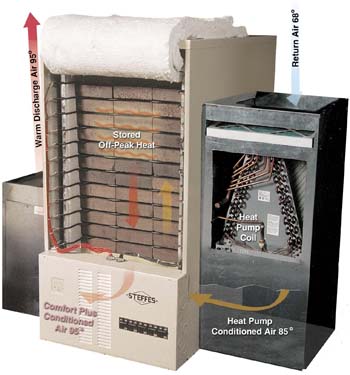 The room thermostat in the home is set to desired comfort level. If room temperature decreases below the room thermostat set point, the system is energized to deliver heat.
The room thermostat in the home is set to desired comfort level. If room temperature decreases below the room thermostat set point, the system is energized to deliver heat.- Upon a heat call from the room thermostat, the heat pump’s outdoor compressor unit is energized and warms the A-coil in the return air duct of the Comfort Plus unit. At the same time, the Comfort Plus unit’s supply air blower is energized.
- The supply air blower draws air from the home (shown at 68° F) across the air filter and the heat pumps A-coil extracting heat from the coil as it passes through it.
- A sensor monitors air temperature after the A-coil. If the air temperature is warm enough to provide comfort to the homeowner (generally 90° F or higher), the supply air blower simply delivers the warm heat into the home through the supply air duct. Air temperature after coil in the diagram is shown at 85° F.
- If air temperature after the heat pump coil is below a comfortable level (generally less than 90° F), the Comfort Plus unit’s core blower will modulate low cost, “Off-Peak” stored heat into the duct stream so comfortable heat (generally 90° F or higher) can be delivered into the home.
- Since heat pumps generally have an operating efficiency of 150%-300% or greater (depending on outdoor temperature), the Comfort Plus system first utilizes the heating ability the heat pump offers. If the heat pump doesn’t have the ability to satisfy comfort and space heating requirements, the Comfort Plus system starts to work with the heat pump utilizing low cost, off-peak energy to ensure comfort for the user at all times. Combining the heat pump’s efficiency with the “Off-Peak” Comfort Plus system yields very low operating costs for the end user along with great comfort.
Comfort Plus Forced Air Furnaces (4100 Series)
| MODEL |
4120
|
4130 |
4140 |
| Charging Input |
14.0 kW |
19.2 kW |
24.8 kW |
28.8 kW |
37.2 kW |
38.4 kW |
45.6 kW |
| Element Current Draw |
59 amps |
80 amps |
104 amps |
120 amps |
155 amps |
160 amps |
190 amps |
|
Circuits Required
Elements
Blowers/Control
|
1-20 AMP
2-30 AMP-30 AM |
1-30 AMP
2-40 AMP |
1-40 AMP
2-50 AMP |
4-40 AMP |
4-50 AMP |
4-50 AMP |
4-60 AMP |
| 1-15 amp (7 amps maximum load) |
| Unit is factory-configured with multiple-line voltage, single-phase circuit connections. If single feed to the element and blowers/controls circuits is desired, an optional single-feed kit is available. Phase-balancing is recommended when making connections in 3-phase applications. |
Storage Capacity
|
120 kWh (426,500 BTU) |
180 kWh (614,160 BTU |
240 kWh (818,880 BTU) |
| The size and heating ability of the system required for an application is dependent on the heat loss of the area and the power company’s off-peak hours. Refer to the Maximum Maintainable Heat Loss for heating abilities in specific charge strategies. |
Approximate Installed Weight
|
2,183 lbs |
3,031 lbs |
3,859 lbs |
| Contact a building contractor or architect if you have structural weight concerns of the installation surface selected. Adhere to all national and local electrical and building code placement requirements for electric heating appliances. |
Unit Dimensions – (W x D x H)
w/o Ducting
w/ Factory-Built Ducting (1/2 HP)
w/ Factory-Built Ducting (1 HP) |
29.2” x 44.7” x 46.6”
77.6” x 44.7” x 46.6”
82.1” x 44.7” x 46.6”
|
29.2” x 44.7” x 57.6”
77.6” x 44.7” x 57.6”
82.1” x 44.7” x 57.6” |
29.2” x 44.7” x 68.6”
77.6” x 44.7” x 68.6”
82.1” x 44.7” x 68.6” |
| There are required installation clearances to account for. Contact the factory for this information. |
Duct Openings
Supply Air Outlet (1/2 HP)
Supply Air Outlet (1 HP)
Return Air Inlet |
18” x 22.6” (in factory-built plenum)
22.5” x 22.6” (in factory-built plenum)
10.5” x 22.3” (in unit) or 26.2” x 22.25” (if using a factory-built plenum) |
Maximum Coil Dimensions
(W x D x H)
|
26” x 22“ x 31” |
| The factory-built return air plenum is configured for housing an indoor coil. Dimensions listed are that of the inner coil area in this plenum. For larger coils, field provisions to the plenum are necessary or it will need to be supplied by the installer. |
Supply Air Delivery (Field Selectable)
1/2 HP Variable Speed CFM ratings
3/4 HP Variable Speed CFM ratings |
1000, 1200, 1400, 1600
1200, 1400, 1600, 2000 |
Heating Ability Based on Charge Time (BTU/hr)
8 Consecutive Charge Hours
12 Consecutive Charge Hours
6/4/6/8 Charge Strategy
|
20,414
30,621
45,931 |
28,013
42,002
62,986
|
34,188
45,550
81,376
|
42,002
62,986
94,478
|
49,201
65,613
122,047
|
55,991
84,003
125,971
|
65,613
87,484
131,225
|
| The size and heating ability of the system required for an application is dependent on the heat loss of the area and the power company’s off-peak hours. If the unit is not installed within the heated area, heat lost statically must be taken into account. Contact a local Steffes dealer or your power company for assistance in selecting an appropriately sized system for your specific charge strategy. The 6/4/6/8 strategy listed is 8 hours off-peak at night plus 4 hours off-peak mid-day. (The heating ability figures listed have a heat use allowance factored in for sizing purposes. Average BTU/hr delivery rate is the listed value multiplied by .78 heat use factor.) |
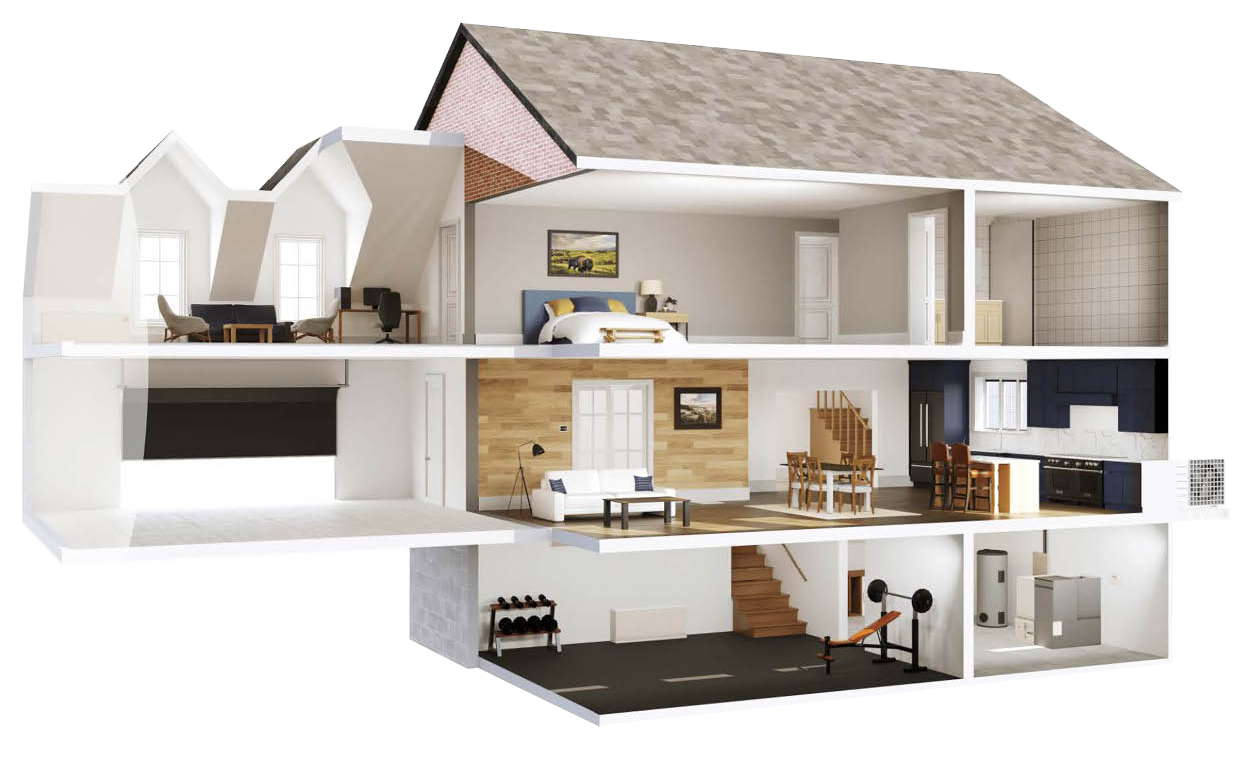
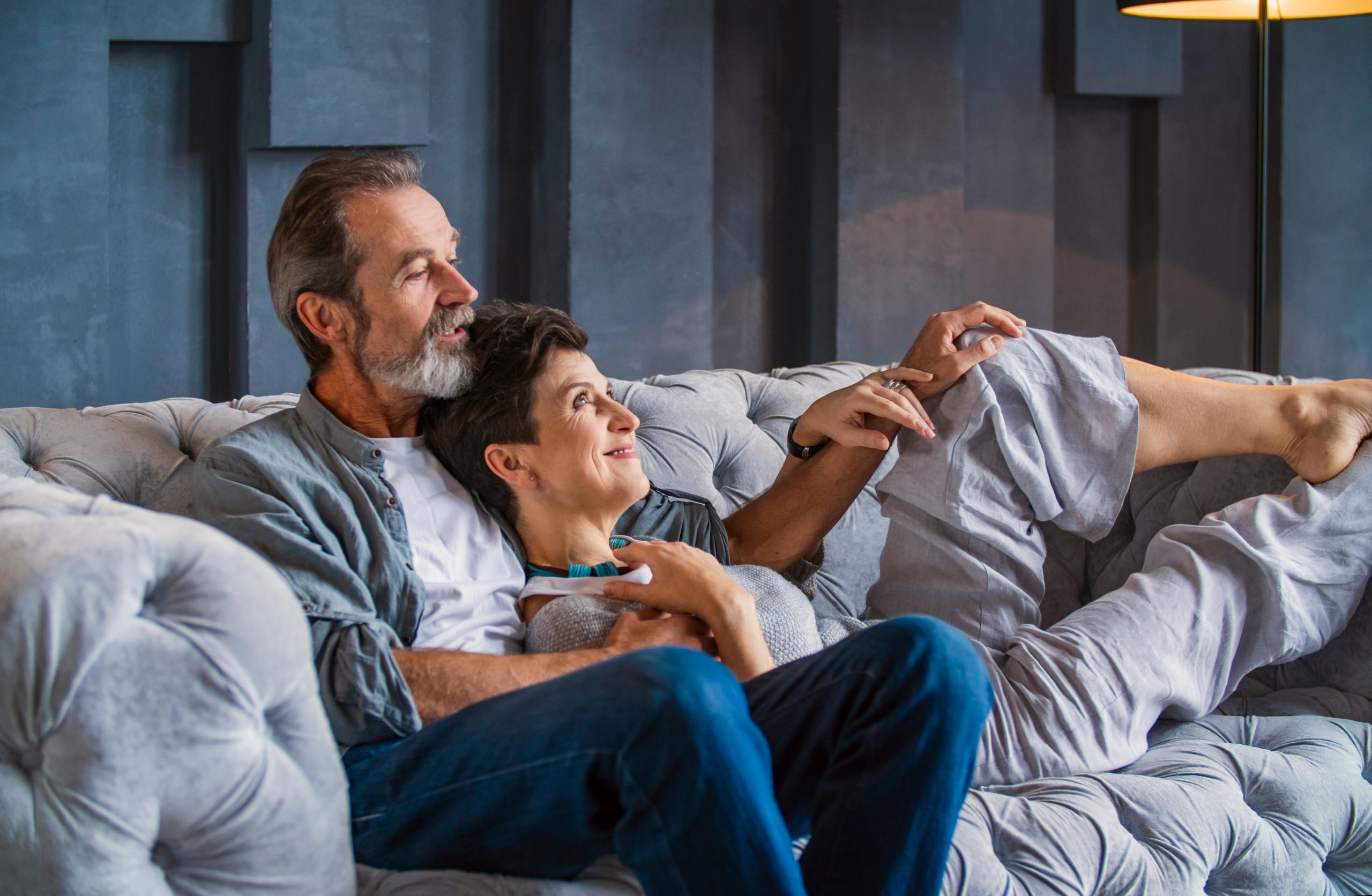
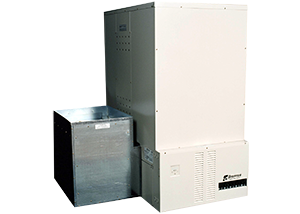 The Steffes Comfort Plus Forced Air Furnace (4100 Series) is a ducted heating system designed to stand alone or work in conjunction with a heat pump for increased efficiency. All Steffes Comfort Plus Forced Air Furnaces are equipped with a variable speed blower to ensure consistent, even temperature output to meet your comfort requirements. While heat pumps are known for providing efficient low-cost heating and cooling, they require supplemental heat during colder temperatures. When demand for heat is greater than a heat pumps capacity, the Comfort Plus Forced Air Furnace adds the precise amount of its stored off-peak heat as needed to ensure constant comfort while still allowing full optimization of the heat pumps efficiency.
The Steffes Comfort Plus Forced Air Furnace (4100 Series) is a ducted heating system designed to stand alone or work in conjunction with a heat pump for increased efficiency. All Steffes Comfort Plus Forced Air Furnaces are equipped with a variable speed blower to ensure consistent, even temperature output to meet your comfort requirements. While heat pumps are known for providing efficient low-cost heating and cooling, they require supplemental heat during colder temperatures. When demand for heat is greater than a heat pumps capacity, the Comfort Plus Forced Air Furnace adds the precise amount of its stored off-peak heat as needed to ensure constant comfort while still allowing full optimization of the heat pumps efficiency.
 The room thermostat in the home is set to desired comfort level. If room temperature decreases below the room thermostat set point, the system is energized to deliver heat.
The room thermostat in the home is set to desired comfort level. If room temperature decreases below the room thermostat set point, the system is energized to deliver heat.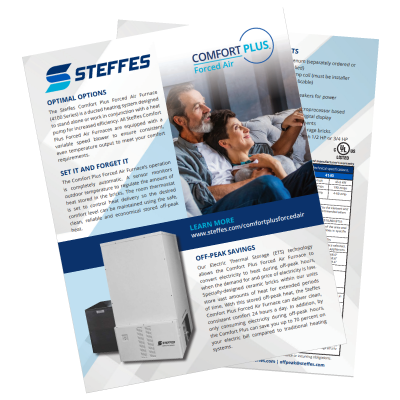
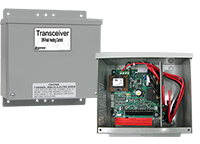 Steffes Transceivers regulate operation of Steffes heating systems and other electric loads to take advantage of off-peak electricity. When the transceiver receives a signal, its internal relays will activate to regulate operation of directly connected loads. At the same time, it will transmit a wireless PLC signal to any device having a corresponding Steffes receiver. This transceiver can also transmit outdoor temperature information to Steffes heating systems for automatic regulation of heat storage in the bricks.
Steffes Transceivers regulate operation of Steffes heating systems and other electric loads to take advantage of off-peak electricity. When the transceiver receives a signal, its internal relays will activate to regulate operation of directly connected loads. At the same time, it will transmit a wireless PLC signal to any device having a corresponding Steffes receiver. This transceiver can also transmit outdoor temperature information to Steffes heating systems for automatic regulation of heat storage in the bricks.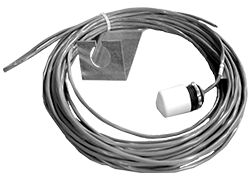 This accessory provides outdoor temperature information for automatically regulating brick core temperature.
This accessory provides outdoor temperature information for automatically regulating brick core temperature.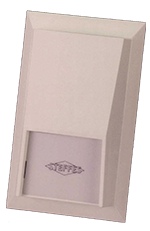 This sensor provides remote room temperature information to room units or it can be used to provide freeze protection temperature signals to furnaces.
This sensor provides remote room temperature information to room units or it can be used to provide freeze protection temperature signals to furnaces.